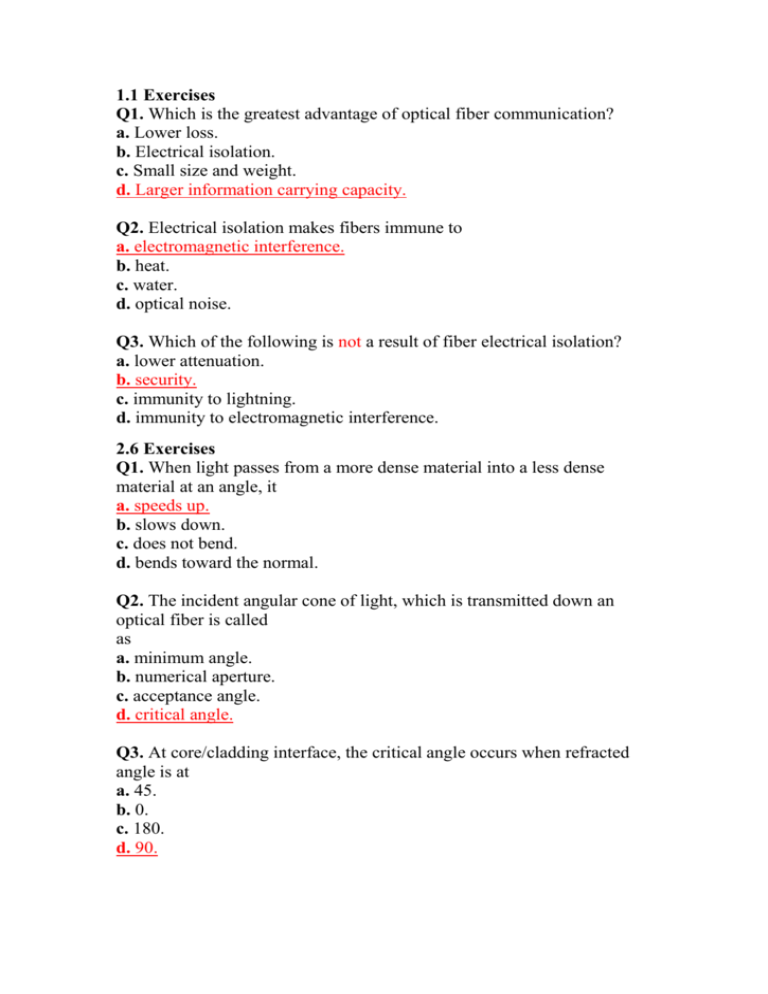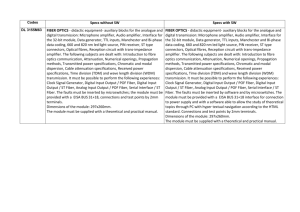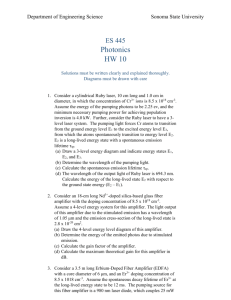c. - NETWORKING SYSTEM
advertisement

1.1 Exercises Q1. Which is the greatest advantage of optical fiber communication? a. Lower loss. b. Electrical isolation. c. Small size and weight. d. Larger information carrying capacity. Q2. Electrical isolation makes fibers immune to a. electromagnetic interference. b. heat. c. water. d. optical noise. Q3. Which of the following is not a result of fiber electrical isolation? a. lower attenuation. b. security. c. immunity to lightning. d. immunity to electromagnetic interference. 2.6 Exercises Q1. When light passes from a more dense material into a less dense material at an angle, it a. speeds up. b. slows down. c. does not bend. d. bends toward the normal. Q2. The incident angular cone of light, which is transmitted down an optical fiber is called as a. minimum angle. b. numerical aperture. c. acceptance angle. d. critical angle. Q3. At core/cladding interface, the critical angle occurs when refracted angle is at a. 45. b. 0. c. 180. d. 90. Q4. Which type of fiber varies the index between the central core and the cladding? a. Step-index. b. Single-mode. c. Graded-index. d. Multimode. Q5. The transfer of energy between modes is called a. transfer function. b. dispersion. c. attenuation. d. crosstalk. Q6. Single-mode and multimode fibers are defined according to their core a. hardness. b. diameter. c. bend radius. d. index. Q7. Sometimes …………….. material is added to outside for greater cable protection. a. buffer. b. sheathing. c. soft. d. cladding. Q8. Which of the following provides outer cable protection against abrasion and chemical reagents present in the application environment? a. Shirt. b. Loose buffer. c. Jacket. d. Strength member. 3.3 Exercises Q1. Which of the following is not considered as a cause for fiber loss? a. Bending. b. Absorption. c. Polarizing. d. Scattering. Q2. The minimum absorption in glass fiber occurs at a. 850 nm. b. 1100 nm. c. 1310 nm. d. 1550 nm. Q3. Absorption in glass fiber today is primarily caused by a. silica. b. OH. c. germanium. d. rare earth impurities. Q4. Which of the following is not a type of fiber dispersion? a. Modal. b. Polarizing mode. c. Chromatic. d. Coherent. Q5. The maximum absorption in glass fiber occurs at ………. a. 850 nm. b. 1100 nm. c. 1310 nm. d. 1550 nm. 4.4 Exercises Q1. Before cleaving a fiber, the fiber should be a. Washed in water. b. weighed. c. covered. d. stripped. Q2. Extrinsic fiber connector losses are caused by differences in the a. connectors. b. receiver. c. fiber. d. system. Q3. Return loss is the result of fiber a. lateral displacement. b. NA mismatch. c. angular displacement. d. end separation. Q4. Mechanical splice alignment is accomplished by using a. three steel rods. b. index matching gel. c. guessing. d. fiber video monitor. Q5. Before cleaving a fiber, the fiber should be a. stripped b. washed in water. c. covered. d. weighed. Q6. Standard connectors are all based on a a. small form factor. b. push-pull connector c. 2.5 mm ceramic ferrule. d. snap-in plug. Q7. MT type connector holds a. fiber cables. b. single fiber. c. stacked connectors. d. 12 fibers. Q8. The LC connector has ………… as many fibers as standard connectors but in the same area. a. only. b. half. c. twice. d. three times. 5.5 Exercises Q1. Planck’s law describes mathematically a. the energy of a photon. b. the size of an electron. c. the absorption angle. d. the difference between absorption and scattering. Q2. The process of photon production without the participation of an additional photon is called as a. stimulated emission. b. absorption. c. quantum emission. d. spontaneous emission. Q3. Stimulated emission results in a. a single photon. b. absorption of a photon. c. a second photon at the same wavelength as the external photon. d. optical energy converted into electrical energy. Q4. The optical source must primarily be matched to the a. fiber. b. network. c. input. d. wavelength. Q5. Which of the following source parameter does not need to be matched to the fiber? a. numerical aperture. b. linewidth. c. material. d. wavelength. Q6. LEDs and laser diodes are generally fabricated from column ………….. elements in the periodic table. a. II-VI. b. III-V. c. I-VII. d. IV-VIII. Q7. LEDs that have light emitted through the p-region are called as a. positive-emitting. b. edge-emitting. c. p-type. d. surface-emitting. Q8. The process of …………… occurs when an external photon hits an excited-state electron forcing a second photon to be emitted at the same wavelength. a. stimulated emission. b. optical absorption. c. emission spectra. d. spontaneous emission. Q9. The laser which has a Braggy grating inside the hetrostructure is called as a. buried hetrostructure. b. distributed feedback. c. quantum well. d. distributed Braggy reflector. Q10. The ……………. describes the ability of a single longitudinal-mode laser to suppress secondary modes. a. drive current. b. signal-to-noise ratio. c. cavity length. d. mode-suppression-ratio. 6.5 Exercises Q1. Which of the following is not a function of a optic fiber transmitter? a. Converting an electrical signal into an optical one.. b. Coupling the signal into an optical fiber. c. Converting the signal from analog to digital.. d. Modulating the signal. Q2. What is the primary modulation method in fiber optic communication? a. Frequency. b. Phase. c. Pulse width. d. Amplitude. Q3. The main problem with direct modulation of a fiber optic source is a. chirp. b. attenuation. c. source-to-fiber coupling. d. higher numerical aperture. Q4. For LED to single-mode fiber coupling, efficiencies can be as little as a. 60%. b. 1%. c. 90%. d. 30%. 7.3 Exercises Q1. The fundamental process of photodetection begins with a. conduction. b. absorption. c. resistance. d. noise. Q2. The distance at which the initial transmitted power level falls to 1/e of its original value is called as a. absorption length b. penetration depth. c. depletion depth. d. all of the above. Q3. A …………. Photodiode uses a standard junction diode to detect light, although it is generally not fast enough for fiber optic communications. a. Metal-semiconductor-metal (MSM). b. PIN. c. APD. d. pn. Q4. A …………. Photodiode contains a lightly-doped intrinsic region between n- and pregions. a. MSM. b. PIN. c. APD. d. pn. Q5. For digital signal recovery, the …………. compares the incoming signal level to a threshold voltage to determine a one or a zero. a. decision circuit b. equalizer. c. clock recovery circuit. d. transimpedance amplifier. Q6. The minimum detectable power level is called the a. power margin. b. sensitivity. c. noise margin. d. dynamic range. 8.3 Exercises Q1. A reduced bandwidth is one of the drawbacks with a a. high impedance amplifier. b. noisy system. c. main amplifier. d. signal recovery circuit. Q2. Which of the following converts the photodiode current to a voltage? a. high impedance amplifier. b. transimpedance amplifier. c. main amplifier. d. signal recovery circuit. Q3. Which of the following uses a second stage to maximize gain and bandwidth and sometimes called the linear channel? a. high impedance amplifier. b. transimpedance amplifier. c. main amplifier. d. Pre-amplifier. Q4. A 3R device does not a. amplify. b. reflect. c. reshape. d. retime. Q5. A ………….. device amplifies only. a. 3R. b. 2R. c. 4R. d. 1R.









